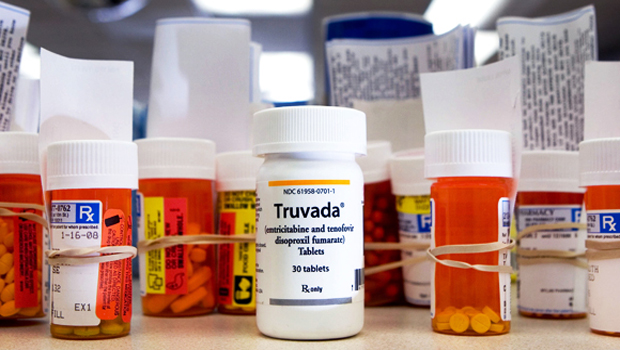
In November, 2010, the New England Journal of Medicine published the results of a three-year clinical trial, funded by the National Institutes of Health, announcing the arrival of a treatment that could reduce the risk of contracting H.I.V. by more than ninety per cent. The treatment involved a blue, oval pill containing emtricitabine and tenofovir. Marketed under the brand name Truvada, the pill was synthesized in 2004 by Gilead Sciences, the world’s largest producer of branded H.I.V. drugs, and has been used in combination with other antiretrovirals as a primary treatment for people living with AIDS. The N.I.H. team discovered that a daily dose of Truvada not only suppressed the virus in people who were already infected but also prevented healthy people from contracting H.I.V. in the first place. Following the N.I.H. study, which tracked gay men in Peru, Ecuador, Brazil, South Africa, Thailand, and the United States, additional trials showed the drug to be effective for heterosexual men and women, as well as for injection-drug users. Researchers called the treatment “pre-exposure prophylaxis,” or PrEP for short. Others have called it “the new condom.”
On the day the N.I.H. announced the results of the PrEP study, the research team received a congratulatory phone call from President Obama. Shortly thereafter, Time put PrEP in the first slot on its list of the year’s top medical innovations. Dr. Robert Grant, a professor at the University of California San Francisco and the N.I.H. study’s lead scientist, braced for a stampede. He told me, “The evening before we announced, we had meetings with the leadership of public health in California, and they were thinking, as we were, that there was going to be a rush, that everyone was going to descend on the clinics.” The Centers for Disease Control issued interim usage guidelines, despite the fact that the treatment was more than a year away from formal F.D.A. approval. The C.D.C. knew that some doctors were already prescribing Truvada for prevention off-label, and it expected more to follow suit.
But, in fact, adoption of the drug has been slow. According to Dawn Smith, a biomedical interventions implementation officer in the C.D.C.’s epidemiology branch, at least half a million Americans are good candidates for PrEP—meaning that they are at high risk for contracting H.I.V. through sexual activity—yet only a few thousand Americans are receiving the treatment. “As in most fields, many clinicians don’t want to be the first one out of the gate,” Smith said. Salim Karim, the chair of United Nations’ AIDS Scientific Expert Panel and the director of the Centre for the AIDS Programme of Research in South Africa, thinks that doctors’ hesitance may not have anything to do with sexual health. “Clinicians fundamentally have difficulty giving healthy people drugs,” he said. “This is not unique to H.I.V.” Meanwhile, despite repeated demonstrations that Truvada provides protection from H.I.V., an estimated hundred and fifty thousand Americans, more than a third of whom are in their teens and twenties, have become infected with the virus since the results of the study were released.
The medical community’s reluctance to prescribe Truvada—and patients’ reluctance to request it—also stems from a bitter fight over the treatment. Critics have questioned PrEP’s safety, efficacy, and cost, and have accused the government of colluding with the drug manufacturer at the expense of public health. Regan Hofmann, the former editor-in-chief of Poz, a magazine for people living with AIDS, called PrEP a “profit-driven sex toy for rich Westerners.” Michael Weinstein, the head of the AIDS Healthcare Foundation (A.H.F.), the world’s largest AIDS organization and the primary-care provider for more than two hundred thousand patients around the world, predicted a public-health catastrophe. “The applause for this approach shows just how disposable we consider the lives of gay men,” he wrote. When I interviewed Weinstein, he claimed the studies were “rigged” and that PrEP was essentially a plot by Gilead to force young people into buying unnecessary medication, and that it was going badly because A.H.F. wasn’t letting the company get away with it.
These kinds of claims helped to shape perceptions of the drug among patients, doctors, and journalists. At an open F.D.A. hearing in May, 2012, busloads of A.H.F. employees showed up to make statements against PrEP, raising questions about the drug’s side effects, its price tag, its potential to incite risky behavior, its failure to prevent other S.T.D.s, and the possibility that imperfect adherence to the pill’s daily regimen would lead to the spread of a Truvada-resistant strain of H.I.V. Though data from the studies largely contradicts these criticisms, they were widely circulated. “I think the advocacy that A.H.F. did was very effective,” Weinstein told me. “We were quoted in virtually every article that was written.”
Gilead’s efforts to promote Truvada for PrEP treatments have been somewhat meagre. “In any other kind of F.D.A. approval, there would have been beautiful ads, lots of TV, and lots of press touting the fact that this was the new thing to keep people protected from H.I.V.,” said Ernest Hopkins, the director of legislative affairs for the San Francisco AIDS Foundation. “Gilead chose not to do that.” According to Jim Rooney, Gilead’s vice-president of medical affairs, the company “spends several million dollars” on educational initiatives related to PrEP, delivered through third-party groups, but it “does not view PrEP as a commercial opportunity.” Truvada is already a blockbuster drug for Gilead; it earned the company more than three billion dollars in global sales in 2012. As Rooney notes, “The role of antiretrovirals in H.I.V. prevention is not yet defined and not yet broadly accepted.” Although Gilead has donated drugs to researchers working on PrEP, it has not undertaken its own study. According to Jim Pickett, the director of prevention advocacy at the AIDS Foundation of Chicago, “Pharmaceutical companies had to be dragged into new prevention research. They weren’t excited about it. They didn’t want to do it.”
* * *
PrEP’s main problem is that many public-health officials believe people will see it as a substitute for condoms. Out magazine provoked a backlash when it printed a positive report on PrEP in early September, called “Is This the New Condom?” Commenters berated the author, Tim Murphy, and accused the magazine of irresponsibly promoting an unproven medicine at the expense of condoms.
Unfortunately, as Grant points out, when it comes to preventing H.I.V. the perceived efficacy of condoms “exceeds their public-health value.” According to the C.D.C.’s Smith, condoms provide a high degree of protection when they’re used consistently, but data shows that very few people use them consistently enough to derive a substantial benefit, and self-reported condom use falls precipitously when people are asked repeatedly if they’re using condoms over an extended period of time. In the data analyzed by the C.D.C., the difference in protection levels for those who sometimes use condoms and those who never use them was not statistically significant.
The corresponding figures for PrEP are much better: while adherence is a concern, as it is with condoms, Truvada offers H.I.V. protection that is more effective than any other method short of abstinence. In the N.I.H. study, for example, 5.2 per cent of the placebo group “seroconverted,” or became H.I.V. positive, compared with 2.9 per cent of the Truvada group. That’s a forty-four-per-cent added protection over-all—better than inconsistent condom use. More impressively, patients who maintained a detectable amount of the drug in their system were protected at a rate of ninety-five per cent. (A later statistical analysis estimated that the drug would need to be taken four times a week to offer protection in that range.) Grant said that people in the study who took the drug four to seven days a week “were absolutely protected. We didn’t have anyone seroconvert in our cohort in the United States.”
Taking Truvada to prevent H.I.V. comes with very few risks. In the N.I.H. study, one in two hundred people had to temporarily go off the pill owing to kidney issues, but even those people were able to resume treatment after a couple of weeks. While bone-density loss occasionally occurs in Truvada takers who are already infected with the virus, no significant bone issues have emerged in the PrEP studies. And though about one in ten PrEP takers suffer from nausea at the onset of treatment, it usually dissipates after a couple of weeks. According to the U.N. panel’s Karim, Truvada’s side-effects profile is “terrific,” and Grant said that common daily medications like aspirin and birth control, as well as drugs to control blood pressure and cholesterol, are all arguably more toxic than Truvada.
Perhaps more important, drug resistance has not been observed in people who were H.I.V.-negative when they began treatment. “We’re not seeing people getting infected who are actually taking the drug,” said Grant. “There are people who take the drug home with them and choose not to take it; they get infected, but you’re not going to get drug resistance from something that stays in a drawer.” Some patients who entered the trials turned out to already have an H.I.V. infection that was too recent to be caught by a blood test. These subjects showed a small amount of drug resistance, which is why the F.D.A. now requires doctors to conduct an H.I.V. test before putting their patients on PrEP. The larger resistance threat, though, comes from the ten million H.I.V.-positive people around the world who take antiretrovirals for treatment, including, in some cases, Truvada. “The best way to prevent drug resistance is to prevent H.I.V. infection entirely,” said Grant. “We know that when we prevent a case of H.I.V., we’re preventing a lifelong risk of drug resistance.”
Whether using PrEP will cause patients to abandon condoms and increase their number of sexual partners isn’t known. Grant insists that the evidence does not support such a conclusion: “Everyone said that if we offer pre-exposure prophylaxis to people, even in a randomized trial, like we did, it’s just going to cause them to have more sexual partners and stop using condoms. We found the opposite: that people had fewer sexual partners and used condoms more.” Then again, participants in the major PrEP studies received free condoms and regular sexual-health counselling. They also may not have been telling the truth about their sexual practices. Ken Mayer, a professor of medicine at Harvard Medical School and Director of H.I.V. Prevention Research at Beth Israel Deaconess Medical Center, believes that some migration away from condoms and toward Truvada is inevitable, but that it wouldn’t necessarily be a bad trade-off, given PrEP’s efficacy and the fact that many of the people likely to go on the treatment don’t use condoms anyway. This squares with my own conversations with people on PrEP: most of them are seeking PrEP not because they wish to abandon condoms but because they already don’t use them. The C.D.C.’s usage guidelines stress that PrEP is something to be taken in addition to using condoms, since PrEP doesn’t protect against other sexually transmitted diseases.
Cost, at least in the United States, has also turned out to be a smaller concern than initially predicted. Smith said, “We were very surprised to find out the insurance companies said, ‘Yes, we’ll pay for it. It’s much more expensive to treat people who have H.I.V. infections.’ ” While a lot of people at high risk for contracting H.I.V. currently lack health insurance, after January 1st many of them will be able to get coverage through Obamacare. And for those who still don’t have insurance or who have unmanageable co-pays, Gilead provides assistance to purchase the drug, which has a sticker price of thirteen thousand dollars a year.
* * *
In the developing world, however, where even delivering cheap generic versions of Truvada can be a challenge, it remains unclear whether diverting resources to prevention on a wide scale makes sense. Mitchell Warren, the executive director of the AIDS Vaccine Advocacy Coalition, points out, however, that the same argument was once made against using antiretrovirals for treatment. “Ten years ago, people said you couldn’t provide treatment in Africa: people wouldn’t adhere, it was too expensive, it would create resistance,” he said. “Many of those issues have been addressed—they haven’t all been overcome—and now we have ten million people on treatment.” Making PrEP available, particularly to protect young women in sub-Saharan Africa, said Karim, “is essential to achieving an AIDS-free generation.”
Because H.I.V.-positive people who go on antiretrovirals have a drastically reduced risk of transmission, AIDS is spreading more slowly than it used to. Weinstein, of the A.H.F., was among the first to attempt to bring antiretrovirals to Africa. He pointed out that there are ten million people around the world on antiretrovirals today, mostly thanks to George W. Bush’s global AIDS initiative. “If we can double that to twenty million,” he said, “I think we will have brought H.I.V. under control.” Truvada for prevention, one might conclude, is an expansion of that concept.
One of the problems is that PrEP lacks a built-in constituency to advocate for it. “ACT UP is focussed on people already living with AIDS,” said Mayer. And while the opponents of PrEP have been loud and persistent, its supporters tend to be stately and circumspect. Many of the arguments made against Truvada, they note, are the same arguments that proponents of abstinence lodged against birth control in the sixties and against condoms in the eighties. “It takes a long time when it’s a medical intervention that has to do with sexual practices,” said Grant. Gilead predicts that it will take five to ten years for PrEP to become widely used in the U.S., by which time Truvada could be off-patent.
When I corresponded again with Pickett, of the AIDS Foundation of Chicago, after the publication of the Out article and the ensuing backlash, he appeared to disavow some of his enthusiasm regarding PrEP. What opponents needed to understand, he said, was that “no one was really envisioning widespread use of Truvada as PrEP. It really is a niche intervention—which should be targeted and used very strategically. No one wants to hand this out to everyone in a key population.” When pressed, he clarified that he thought Truvada was for anyone in a high-risk group who struggled with monogamy or consistent use of condoms, a delineation that would seem to include millions of people in the United States alone.
While skepticism about PrEP will undoubtedly recede over time, for the moment it remains strong. I was recently speaking with a twenty-six-year-old urban planner living in Brooklyn, who overheard me talking about PrEP. “Oh yeah,” he said, with a worried look. “I’ve heard of that. I saw that piece in Out. It said it doesn’t work, right?”
Note: This article does not necessarily represent the opinions of Paul Morris or Treasure Island Media. We felt it right to post, allowing each of you to digest, and form your own opinion. We look forward to hearing what you think.













